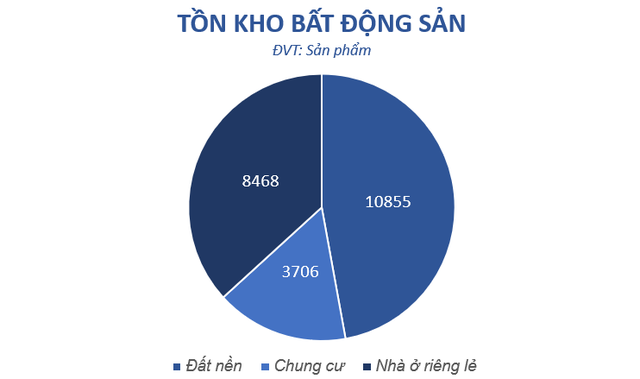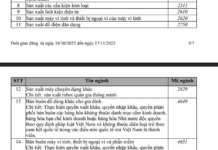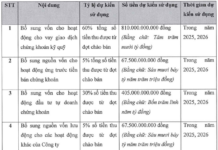Inventory continues to balloon
According to data from the Ministry of Construction, the real estate market has gradually become more vibrant in the first months of the year, with an increasing number of customers looking to buy and sell. Real estate transactions in early 2024 increased by nearly 30% compared to the end of 2023. However, the real estate market still faces many challenges. The number of completed, newly licensed, and qualified-for-sale projects are all lower than the same period last year. Notably, the real estate inventory remains large, mainly consisting of detached houses and land plots, with 19,323 units, a 43% increase compared to last year.

Source: Ministry of Construction
Financial reports from 10 real estate enterprises developing residential projects listed on the stock exchange also indicate that the total inventory value as of June 30 was over VND 269,135 billion, a nearly 3% increase compared to the same period last year. In reality, the inventory value of many enterprises has not decreased but has continued to increase over the years. Notably, Novaland’s inventory has consistently broken records in recent quarters.

Even more strikingly, a report from the Research and Development of Private Economy (IV) previously stated that a real estate enterprise recorded an inventory period of up to 54,334 days, meaning it would take 149 years to sell out their inventory.
What’s causing this issue?
The inventory of enterprises is recorded in two categories: real estate finished products (completed products ready for sale or waiting for handover to customers) and real estate work in progress (basic construction costs, land use costs, etc., of projects in the implementation phase, along with capitalized interest costs). For finished products, in the context of a struggling real estate market, many enterprises have postponed their sales plans, waiting for the market to improve, which has led to a lack of reduction in inventory value for some enterprises.
For work in progress, this is the primary form of inventory for real estate enterprises. The reason for the continuous increase in this type of inventory is the legal obstacles that many projects have faced over the years. It can be seen that after the market boom in supply (in 2018), the approval process for housing projects in urban areas also began to slow down due to the emergence of legal procedural obstacles. This has led to a decrease in supply in the market over the years, especially in major cities like Ho Chi Minh City and Hanoi.
Additionally, another reason for the high inventory is the hot development stage the market went through, with many investors pouring large sums of money into provinces to develop speculative projects such as land plots and resort real estate. Now, with the investment market slowing down, it is challenging to find buyers, and these completed projects cannot be liquidated. It will be difficult for enterprises to resolve this type of inventory in the context of the general market not yet recovering.
The report from Batdongsan.com.vn also points out the irony that while the market lacks new supply, the inventory of listed real estate enterprises remains large, indicating a mismatch between products and the actual needs of the market.
Inventory: A double-edged sword
Inventory is considered a double-edged sword for real estate enterprises in the current context. On the one hand, inventory can be a reserve, but it also potentially poses risks if most are unfinished projects due to legal issues or products that do not match the current market. Therefore, increasing inventory can be an advantage for enterprises to develop rapidly if it is part of their plan. However, in the context of a market with many bottlenecks restraining investors, it is also a concerning issue.
Dr. Nguyen Minh Phong believes that enterprises need to be aware that real estate inventory is a double-edged sword and, therefore, should have appropriate plans for business development and asset structuring. Especially in the context of an uncertain market recovery, holding too much inventory that is not in the form of real estate can be worrying.
From another perspective, Mr. Le Hoang Chau, Chairman of the Ho Chi Minh City Real Estate Association, believes that the most concerning aspect of inventory is when it consists of completed projects that the market does not accept due to low liquidity.
“From any perspective, the high real estate inventory is a warning sign. Financial investors and real estate investors cannot know whether this inventory is part of the enterprise’s strategy or plan or if it is, in fact, unsellable inventory. Only insiders know, so we must remain calm and not panic, but we should also not paint a rosy picture of real estate inventory. We should be concerned about large inventories because it is a sign that forces investors to carefully investigate the business situation of the enterprise,” Mr. Chau shared.
In addition, this expert noted that for weak businesses that use high financial leverage, large inventories would be a “mountain of debt” for the enterprise. If the products are illiquid, the business will face difficulties and very high economic pressure.

The trio of laws coming into effect is expected to help enterprises resolve stalled projects and reduce inventory
From August 1, the trio of laws on Land, Housing, and Real Estate Business officially took effect. This is expected to help real estate enterprises with stalled projects due to legal procedures. However, to solve the inventory problem, real estate enterprises need to develop products that the market needs, which will help with quick liquidation. However, it will take time for the laws to be fully implemented and absorbed.
“With the early effect of the three Laws, we hope to resolve the current issues in the real estate market. However, we still have to wait for the guiding procedures, circulars of the ministries and sectors. So far, several decrees have been issued on land reclamation, land price appraisal, compensation and resettlement, and land survey and evaluation… These are decrees guiding the implementation of the Land Law. There are also two decrees on land use fee collection and residential development decisions, drafted by the Ministry of Finance and submitted to the Government,” said Mr. Dao Trung Chinh, Director of the Department of Planning and Land Development (Ministry of Natural Resources and Environment).
In addition, Dr. Nguyen Van Dinh believes that for the group of finished product inventory, which consists of completed products put on the market but with low transaction volume due to weak liquidity, it is necessary to restructure the prices to be more suitable. The investors must be willing to “sacrifice” part of their profits to sell the products.
As for the group of semi-finished product inventory, these are real estate projects that have been implemented for many years but are still not completed. The solution lies in the hands of state management agencies, who need to consider and expedite the resolution of obstacles for these projects, thereby unlocking the resources.








































